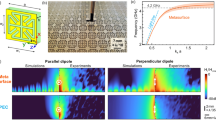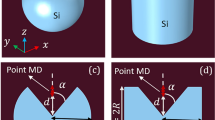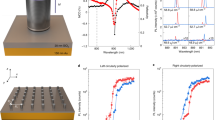Abstract
Magneto-optical phenomena such as the Faraday and Kerr effects play a central role in controlling the polarization and intensity of optical fields propagating through a medium. Intensity effects in which the direction of light emission depends on the orientation of the external magnetic field are of particular interest, as they can be harnessed for routing light. Effects known so far for accomplishing such routing all control light emission along the axis parallel to the magnetic field. Here we report a new class of emission phenomena where directionality is established perpendicular to the externally applied magnetic field for light sources located in the vicinity of a surface. As a proof of principle for this effect, which we call transverse magnetic routing of light emission, we demonstrate the routing of emission for excitons in a diluted-magnetic-semiconductor quantum well. In hybrid plasmonic semiconductor structures, we observe significantly enhanced directionality of up to 60%.
This is a preview of subscription content, access via your institution
Access options
Access Nature and 54 other Nature Portfolio journals
Get Nature+, our best-value online-access subscription
$29.99 / 30 days
cancel any time
Subscribe to this journal
Receive 12 print issues and online access
$209.00 per year
only $17.42 per issue
Buy this article
- Purchase on Springer Link
- Instant access to full article PDF
Prices may be subject to local taxes which are calculated during checkout




Similar content being viewed by others
Change history
04 September 2018
In the version of this Article originally published, the expression for Pc was missing a division slash; it should have read Pc = ±2dydz/(dy2 + dz2) ≈ ±2/3Δh,F/Δ1h. Also, affiliation 5 was missing ‘Institute of Physics’; it should have read ‘International Research Centre MagTop, Institute of Physics, Polish Academy of Sciences, Warsaw, Poland’. These issues have now been corrected.
References
Benson, O. Assembly of hybrid photonic architectures from nanophotonic constituents. Nature 480, 193–199 (2011).
Lodahl, P. et al. Chiral quantum optics. Nature 541, 473–480 (2017).
Temnov, V. V. et al. Active magneto-plasmonics in hybrid metal-ferromagnet structures. Nat. Photon. 4, 107–111 (2010).
Akimov, I. A. et al. Hybrid structures of magnetic semiconductors and plasmonic crystals: A novel concept for magneto-optical devices. J. Opt. Soc. Am. B 29, A103–A118 (2012).
Armelles, G., Cebollada, A., Garca-Martn, A. & González, M. U. Magnetoplasmonics: Combining magnetic and plasmonic functionalities. Adv. Opt. Mater. 1, 10–35 (2013).
Bossini, D., Belotelov, V. I., Zvezdin, A. K., Kalish, A. N. & Kimel, A. V. Magnetoplasmonics and femtosecond optomagnetism at the nanoscale. ACS Photon. 3, 1385–1400 (2016).
Zvezdin, A. & Kotov, V. Modern Magnetooptics and Magnetooptical Materials (IOP, Bristol & Philadelphia, 1997).
Levy, M., Baryshev, A. V. & Inoue, M. (eds) Magnetophotonics: From theory to applications (Springer, Berlin, Heidelberg, 2013).
Belotelov, V. I. et al. Enhanced magneto-optical effects in magnetoplasmonic crystals. Nat. Nanotech. 6, 370–376 (2011).
Chin, J. Y. et al. Nonreciprocal plasmonics enables giant enhancement of thin-film Faraday rotation. Nat. Commun. 4, 1599 (2013).
Kreilkamp, L. E. et al. Waveguide-plasmon polaritons enhance transverse magneto-optical Kerr effect. Phys. Rev. X 3, 041019 (2013).
Floess, D. et al. Plasmonic analog of electromagnetically induced absorption leads to giant thin film Faraday rotation of 14°. Phys. Rev. X 7, 021048 (2017).
Rikken, G. L. J. A. & Raupach, E. Observation of magneto-chiral dichroism. Nature 390, 493–494 (1997).
Bekshaev, A. Y., Bliokh, K. Y. & Nori, F. Transverse spin and momentum in two-wave interference. Phys. Rev. X 5, 011039 (2015).
Leyder, C. et al. Observation of the optical spin Hall effect. Nat. Phys. 3, 628–631 (2007).
Bliokh, K. Y., Rodríguez-Fortuño, F. J., Nori, F. & Zayats, A. V. Spin–orbit interactions of light. Nat. Photon. 9, 796–808 (2015).
Rodríguez-Fortuño, F. J., Engheta, N., Martínez, A. & Zayats, A. V. Lateral forces on circularly polarizable particles near a surface. Nat. Commun. 6, 8799 (2015).
Kapitanova, P. V. et al. Photonic spin Hall effect in hyperbolic metamaterials for polarization-controlled routing of subwavelength modes. Nat. Commun. 5, 3226 (2014).
Aiello, A., Banzer, P., Neugebauer, M. & Leuchs, G. From transverse angular momentum to photonic wheels. Nat. Photon. 9, 789–795 (2015).
Junge, C., O’Shea, D., Volz, J. & Rauschenbeutel, A. Strong coupling between single atoms and nontransversal photons. Phys. Rev. Lett. 110, 213604 (2013).
Shomroni, I. et al. All-optical routing of single photons by a one-atom switch controlled by a single photon. Science 345, 903–906 (2014).
Luxmoore, I. J. et al. Interfacing spins in an InGaAs quantum dot to a semiconductor-waveguide circuit using emitted photons. Phys. Rev. Lett. 110, 037402 (2013).
Söllner, I. et al. Deterministic photon emitter coupling in chiral photonic circuits. Nat. Nanotech 10, 775–778 (2015).
Coles, R. J. et al. Chirality of nanophotonic waveguide with embedded quantum emitter for unidirectional spin transfer. Nat. Commun. 7, 11183 (2016).
Lin, J. et al. Polarization-controlled tunable directional coupling of surface plasmon polaritons. Science 340, 331–334 (2013).
Rodrguez-Fortuño, F. J. et al. Near-field interference for the unidirectional excitation of electromagnetic guided modes. Science 340, 328–330 (2013).
Bauer, T., Orlov, S., Peschel, U., Banzer, P. & Leuchs, G. Nanointerferometric amplitude and phase reconstruction of tightly focused vector beams. Nat. Photon. 8, 23–27 (2013).
O’Connor, D., Ginzburg, P., Rodríguez-Fortuño, F. J., Wurtz, G. A. & Zayats, A. V. Spin–orbit coupling in surface plasmon scattering by nanostructures. Nat. Commun. 5, 5327 (2014).
Petersen, J., Volz, J. & Rauschenbeutel, A. Chiral nanophotonic waveguide interface based on spin–orbit interaction of light. Science 346, 67–71 (2014).
Rodrguez-Fortuño, F. J., Barber-Sanz, I., Puerto, D., Griol, A. & Martnez, A. Resolving light handedness with an on-chip silicon microdisk. ACS Photon. 1, 762–767 (2014).
Lefier, Y. & Grosjean, T. Unidirectional sub-diffraction waveguiding based on optical spin–orbit coupling in subwavelength plasmonic waveguides. Opt. Lett. 40, 2890–2893 (2015).
Sinev, I. S. et al. Chirality driven by magnetic dipole response for demultiplexing of surface waves. Laser Photon. Rev. 11, 1700168 (2017).
Furdyna, J. K. Diluted magnetic semiconductors. J. Appl. Phys. 64, R29–R64 (1988).
Gaj, J. A. & Kossut, J. Introduction to the Physics of Diluted Magnetic Semiconductors (Springer, Berlin, Heidelberg, 2010).
Kuhn-Heinrich, B., Ossau, W., Bangert, E., Waag, A. & Landwehr, G. Zeeman pattern of semimagnetic (CdMn)Te/(CdMg)Te quantum wells in inplane magnetic fields. Solid State Commun. 91, 413–418 (1994).
Bliokh, K. Y., Smirnova, D. & Nori, F. Quantum spin Hall effect of light. Science 348, 1448–1451 (2015).
Seyler, K. L. et al. Ligand-field helical luminescence in a 2D ferromagnetic insulator. Nat. Phys. 14, 277–281 (2018).
Whittaker, D. M. & Culshaw, I. S. Scattering-matrix treatment of patterned multilayer photonic structures. Phys. Rev. B 60, 2610–2618 (1999).
Li, L. Use of Fourier series in the analysis of discontinuous periodic structures. J. Opt. Soc. Am. A. 13, 1870–1876 (1996).
Johnson, P. B. & Christy, R. W. Optical constants of the noble metals. Phys. Rev. B 6, 4370–4379 (1972).
Andre, R. & Dang, L. S. Low-temperature refractive indices of Cd1−xMnxTe and Cd1−xMgxTe. J. Appl. Phys. 82, 5086–5089 (1997).
Aspnes, D. E., Kelso, S. M., Logan, R. A. & Bhat, R. Optical properties of AlxGa1−xAs. J. Appl. Phys. 60, 754–767 (1986).
Acknowledgements
We are grateful to M. M. Glazov, E. L. Ivchenko, V. L. Korenev, I. V. Iorsh and A. K. Samusev for useful discussions. We acknowledge the financial support by the Deutsche Forschungsgemeinschaft through the International Collaborative Research Centre 160 (Project C5). A.N.P. acknowledges the partial financial support from the Russian Foundation for Basic Research grants no. 15-52-12012-NNIO_a and 15-52-12011-NNIO_a and the “Basis” Foundation. M.B. acknowledges support by RF Government grant no. 14.Z50.31.0021. The research in Poland was partially supported by the National Science Centre (Poland) through grant nos DEC-2012/06/A/ST3/00247 and DEC-2014/14/M/ST3/00484, as well as by the Foundation for Polish Science through the IRA Programme co-financed by EU within SG OP.
Author information
Authors and Affiliations
Contributions
F.S., I.A.A., V.F.S, L.K. and L.E.K. performed the experiments and analysed the data. A.N.P. developed the theoretical model. L.V.L. and R.J. carried out electron beam lithography and lift-off processing for plasmonic gratings. G.K., M.W. and T.W. fabricated the semiconductor samples. F.S., A.N.P, I.A.A., D.R.Y. and M.B. conceived the idea for the experiment and co-wrote the paper. All authors discussed the results and commented on the manuscript.
Corresponding authors
Ethics declarations
Competing interests
The authors declare no competing interests.
Additional information
Publisher’s note: Springer Nature remains neutral with regard to jurisdictional claims in published maps and institutional affiliations.
Supplementary information
Supplementary Information
14 pages, 6 figures, 10 references.
Rights and permissions
About this article
Cite this article
Spitzer, F., Poddubny, A.N., Akimov, I.A. et al. Routing the emission of a near-surface light source by a magnetic field. Nature Phys 14, 1043–1048 (2018). https://doi.org/10.1038/s41567-018-0232-7
Received:
Accepted:
Published:
Issue Date:
DOI: https://doi.org/10.1038/s41567-018-0232-7
This article is cited by
-
Tunable directional photon scattering from a pair of superconducting qubits
Nature Communications (2023)
-
Probing nanoscale fluctuation of ferromagnetic meta-atoms with a stochastic photonic spin Hall effect
Nature Nanotechnology (2020)
-
Transverse photon spin of bulk electromagnetic waves in bianisotropic media
Nature Photonics (2019)



